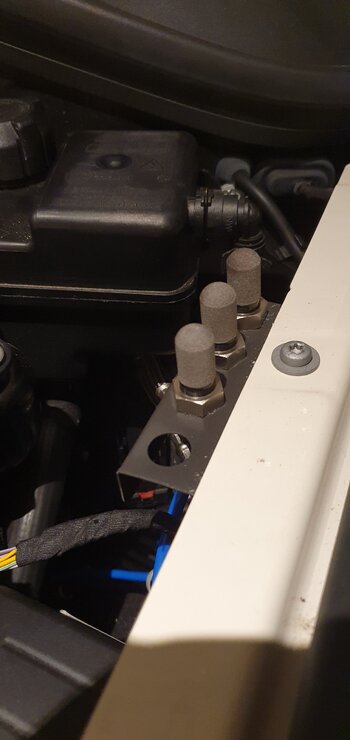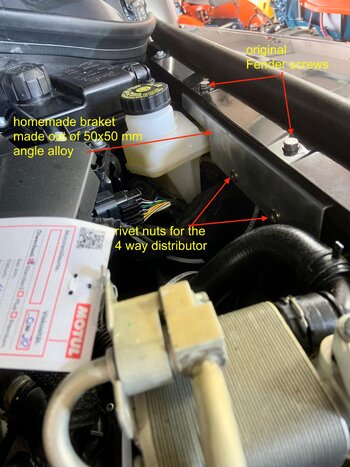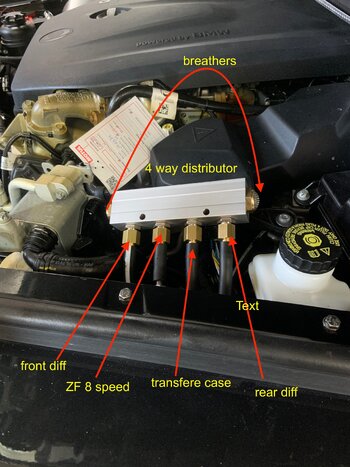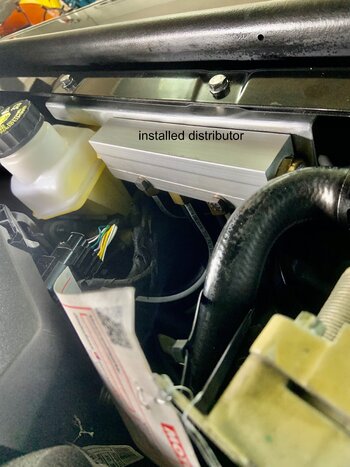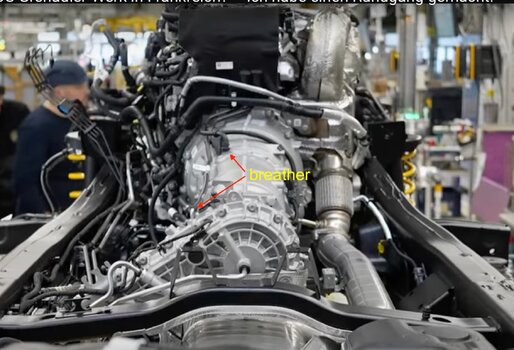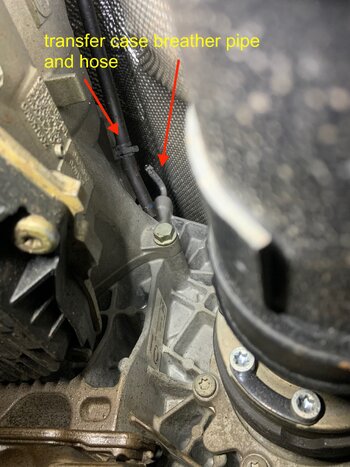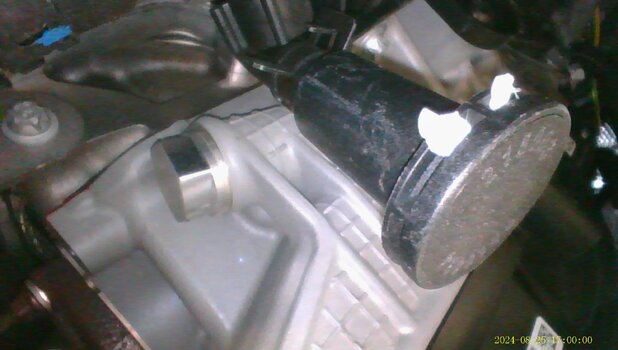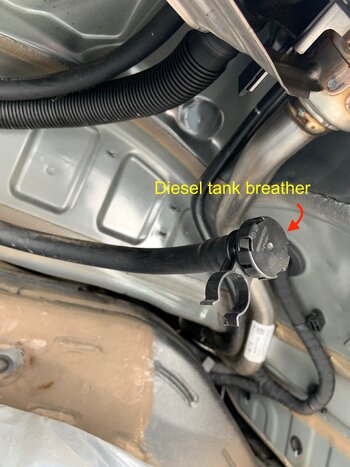The Grenadier Forum
Register a free account today to become a member! Once signed in, you'll be able to contribute to the community by adding your own topics, posts, and connect with other members through your own private inbox! INEOS Agents, Dealers or Commercial vendors please use the contact us link at the bottom of the page.
-
Guest submit your best shot for a chance to win the December Photo Contest. Photo Contest Click Here
You are using an out of date browser. It may not display this or other websites correctly.
You should upgrade or use an alternative browser.
You should upgrade or use an alternative browser.
Diff breathers
- Thread starter RTG
- Start date
My bracket is mounted between the airbox and the fender, but @DenisM makes some good points here:I bought a
Tube Colour: Blue


Diff Breather Kit 4 point for INEOS Grenadier. I am after pic or suggestions where to mount it in the engine bay of my diesel Trialmaster. Thanks
FWIW: I installed the breather bracket on the LHS of the engine bay. It's "sandwiched" between the mudguard and body panels using the exising fasteners.
I added a generous length of hd heat shrink tubing over each breather /air-line connection to preclude mud/sand etc, and then lengths of split-seam conduit for protection on exposed sections. The air-lines are thus routed well away from any potential heat sources ...
I added a generous length of hd heat shrink tubing over each breather /air-line connection to preclude mud/sand etc, and then lengths of split-seam conduit for protection on exposed sections. The air-lines are thus routed well away from any potential heat sources ...
My OEM diff breather values were replaced last week (I had a diff breather kit installed). Even though I have not done water crossings or mud work, the OEM valves were beginning to clog up. GrenX confirmed they have seen this issue before and believe it is causing some of the oil leakages in the diff when the valve clogs up and pressure builds.
I now have a diff breather kit fitted, but if I had the OEM valves I would routinely check they are not clogged up. Simply press them a few times to make sure they are not clogged.
Rohan also mentioned the fitted diff breather hoses were close...
I now have a diff breather kit fitted, but if I had the OEM valves I would routinely check they are not clogged up. Simply press them a few times to make sure they are not clogged.
Rohan also mentioned the fitted diff breather hoses were close...
I used the same spot in the engine compartment for my breather kit. The related parts are from compressed air technology. The bracket is made of 50x50x3 mm aluminum and uses the existing fender screws. The 4-way air distributor can be easily removed, and each individual line can be blown out with compressed air.
The ZF transmission is currently not connected because I cannot access the connections on the transmission. To get there, you have to remove the front driveshaft.
The ZF transmission is currently not connected because I cannot access the connections on the transmission. To get there, you have to remove the front driveshaft.
Attachments
If you place the breathers for the differentials on one side and the breathers for the gearboxes on the other side, this location is even better than my solution , provided you use plastic tubing.
Last edited:
Did you ever get around to connecting the transmission?I used the same spot in the engine compartment for my breather kit. The related parts are from compressed air technology. The bracket is made of 50x50x3 mm aluminum and uses the existing fender screws. The 4-way air distributor can be easily removed, and each individual line can be blown out with compressed air.
The ZF transmission is currently not connected because I cannot access the connections on the transmission. To get there, you have to remove the front driveshaft.
Im planning on doing the diffs but after a quick look into the tunnel the tranny breathrr wasnt very obvious so any pointers/ photos would be of great help.
Removing the front driveshaft doesnt sound as easy as tge front and rear diffs.
G.
if you wait long enough it removes itself!Did you ever get around to connecting the transmission?
Im planning on doing the diffs but after a quick look into the tunnel the tranny breathrr wasnt very obvious so any pointers/ photos would be of great help.
Removing the front driveshaft doesnt sound as easy as tge front and rear diffs.
G.
So far, I've only connected the differentials and the transfer case. I'm waiting to connect it to the ZF transmission until my front driveshaft fails and needs to be removed. Accessing the breather is difficult without removing the front driveshaft. The transmission pictures show where the breathers are located. Both the standard transmission breathers and the diesel tank breather are identical. The transmission breathers are located at the rear of the engine. They can only be accessed by removing the body panel below the windshield wipers.
Accessing the breather is difficult without removing the front driveshaft. The transmission pictures show where the breathers are located. Both the standard transmission breathers and the diesel tank breather are identical. The transmission breathers are located at the rear of the engine. They can only be accessed by removing the body panel below the windshield wipers.
Attachments
No, it is all standard.
So are the transmission breathers already piped to somewhere under the bonnet/ hood? And what are they currebtly terminated with?So far, I've only connected the differentials and the transfer case. I'm waiting to connect it to the ZF transmission until my front driveshaft fails and needs to be removed.Accessing the breather is difficult without removing the front driveshaft. The transmission pictures show where the breathers are located. Both the standard transmission breathers and the diesel tank breather are identical. The transmission breathers are located at the rear of the engine. They can only be accessed by removing the body panel below the windshield wipers.
G.
You'll need to take a cut lunch and a compass to find the transmission and transfer case breathers between the engine cylinder head and the firewall. That'll make you @Grumpy!So are the transmission breathers already piped to somewhere under the bonnet/ hood? And what are they currebtly terminated with?
G.
Or use a boroscope
I think @Greasemonkey's breather4 image is a boroscope pic from that location. I have rotated and deskewed it using AI so take it as a reasonable representation.
This view would be looking "through" the firewall on the right side towards the back of the engine. The cast exhaust manifold is visible on the right. The shiny alloy is the back of the head.
The rocker cover and top of the head is bent like a banana due to deskewing. It should be straight across. Don't buy your knock-off car parts from AI Autos.
A plastic breather and round cap is in the foreground.
Original pic credit to @Greasemonkey
Petrol. HP51 transmission.
Diesel. HP76 transmission.
I can't say for sure whether the photo was taken with a borescope or a mobile phone. I did manage to pull the transfer case breather up a bit with a wire once. The photo probably dates from that attempt. Even with a borescope, I couldn't get a clear view of the breather's mounting from either above or below. However, the workshop manual now shows exactly how the breathers are arranged.
I only connected the transfer case breather because the mechanics forgot to reattach the hose when they replaced the transmission.
The original mounting point for the transmission breather is already quite high. I suspect my connection only added a maximum of 10 cm. So, as long as you maintain the recommended wading depth, everything should be fine.
I only connected the transfer case breather because the mechanics forgot to reattach the hose when they replaced the transmission.
The original mounting point for the transmission breather is already quite high. I suspect my connection only added a maximum of 10 cm. So, as long as you maintain the recommended wading depth, everything should be fine.
That last bit is great advice @Greasemonkey....So, as long as you maintain the recommended wading depth, everything should be fine.
Something for the forum merch shop
In the past, I've probably had more luck than sense when crossing rivers and fords. I wouldn't do that again today, especially considering how expensive a new engine is these days.
Furthermore, I found the YouTube videos by Ben Greggers, Tom Sunderland, and also the Cape York videos very informative, because they show how quickly an engine can be ruined.
Furthermore, I found the YouTube videos by Ben Greggers, Tom Sunderland, and also the Cape York videos very informative, because they show how quickly an engine can be ruined.
We're always worried about how much dust can get into the engine through the RAI or a snorkel.
But it's also interesting to see how much water the engine sucks in during heavy rain.
The picture shows my INEOS idling. The paper towel I held in front of the RAI was immediately sucked in tightly. I don't even want to imagine how much dust or water gets sucked in there while driving.
But it's also interesting to see how much water the engine sucks in during heavy rain.
The picture shows my INEOS idling. The paper towel I held in front of the RAI was immediately sucked in tightly. I don't even want to imagine how much dust or water gets sucked in there while driving.
Attachments
In this Motor Oil Geek YouTube a Donaldson Filters technician talks about 20,000 litres of air passing through the airbox per one litre of diesel fuel. And, surface filters get better after some use so don't clean or replace them too often.We're always worried about how much dust can get into the engine through the RAI or a snorkel.
But it's also interesting to see how much water the engine sucks in during heavy rain.
The picture shows my INEOS idling. The paper towel I held in front of the RAI was immediately sucked in tightly. I don't even want to imagine how much dust or water gets sucked in there while driving.
Similar threads
- Replies
- 84
- Views
- 6K
- Replies
- 8
- Views
- 944
- Replies
- 71
- Views
- 5K

